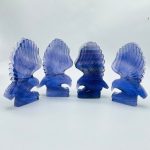
Introduction
Labradorites, named after the Labrador Peninsula in Canada where they were first discovered, are stunning gemstones that have captivated humankind for centuries. These iridescent rocks, formed from the slow cooling of molten lava, exhibit a mesmerizing play of colors that resemble the Northern Lights. Labradorites are not only visually appealing but also possess a fascinating history, cultural significance, and a range of potential applications that are yet to be fully explored.
The Allure of Iridescence
The most striking feature of labradorites is their captivating iridescence, which manifests as shimmering hues of blue, green, gold, and purple. This phenomenon results from the presence of multiple thin layers of different mineral compositions within the gemstone. As light interacts with these layers, it undergoes interference, causing the colors to change depending on the angle at which it is viewed.
The Mineralogy of Labradorite
Labradorites belong to the feldspar group of minerals, specifically classified as plagioclase feldspars. They are composed primarily of aluminum, silicon, and calcium, with varying amounts of sodium and potassium. The presence of these elements in specific proportions gives labradorite its distinctive appearance and physical properties.
The Cultural Significance of Labradorite
Labradorites have been revered in various cultures throughout history. In Norse mythology, they were believed to be shards of the Northern Lights frozen to earth. Native American tribes used them as talismans for protection and guidance. In modern times, labradorites are often associated with spiritual growth, self-discovery, and creativity.
The Potential Applications of Labradorite
While labradorites are primarily known for their ornamental value, they also possess several potential applications due to their unique optical and physical properties.
Optics: Labradorites’ iridescence makes them suitable for use in optical devices such as polarizers, diffraction gratings, and light filters.
Jewelry: Labradorites are highly sought after in jewelry making due to their mesmerizing colors and durability. They are often cut into cabochons or faceted gems for use in necklaces, earrings, bracelets, and rings.
Decoration: Labradorites can be used as decorative elements in various settings. They can be incorporated into interior design as countertops, tiles, or wall panels, adding a touch of elegance and intrigue to any space.
Other Applications: Labradorites are currently being explored for potential use in advanced materials, including semiconductors, lasers, and nanotechnology. Their unique optical and electrical properties make them promising candidates for innovative applications.
The Growing Market for Labradorite
The market for labradorite has been steadily growing in recent years. According to a report by Allied Market Research, the global labradorite market was valued at approximately $119.8 million in 2021 and is projected to reach $183.4 million by 2028, exhibiting a compound annual growth rate (CAGR) of 6.1% during the forecast period. This growth is primarily attributed to increasing demand from the jewelry industry and consumers seeking unique and eye-catching gemstones.
Common Mistakes to Avoid When Dealing with Labradorite
While labradorites are relatively durable gemstones, they can be susceptible to certain types of damage if not handled properly. Here are some common mistakes to avoid:
-
Overexposure to Heat: Labradorites can lose their iridescence if exposed to excessive heat. Avoid wearing them during activities that generate high temperatures.
-
Mechanical Damage: Labradorites should be protected from scratches and impact. Store them in a separate compartment in a jewelry box or pouch to prevent damage.
-
Exposure to Harsh Chemicals: Labradorites can be damaged by contact with harsh chemicals, such as those used in cleaning products. Remove them before cleaning or handling chemicals.
Innovating with Labradorite
The potential applications of labradorite extend far beyond its traditional uses. By embracing a “labradorization” mindset, individuals can generate novel ideas for new applications. “Labradorization” refers to the process of infusing materials or products with labradorite’s unique optical and physical properties, inspiring creative and innovative solutions.
Key Statistics
- The largest known labradorite specimen weighs over 4,000 pounds and is housed at the Canadian Museum of Nature in Ottawa.
- Labradorite is the provincial gemstone of Newfoundland and Labrador, Canada.
- The value of labradorite can vary significantly depending on its size, color, and clarity, ranging from a few dollars to thousands of dollars per carat.
- The demand for labradorite in the jewelry industry is primarily driven by its use in high-end and fashion jewelry.
- Labradorites have been used in various artistic and cultural expressions, including sculptures, paintings, and wearable art.
Conclusion
Labradorites are captivating gemstones that possess a rich history, fascinating optical properties, and a range of potential applications. Their mesmerizing iridescence and cultural significance make them highly sought after in jewelry and decorative arts. As the demand for labradorite continues to grow, researchers and innovators are actively exploring new ways to leverage its unique capabilities. By embracing a “labradorization” mindset, we can unlock novel and inspiring applications for this enigmatic gemstone, pushing the boundaries of possibility and illuminating the path forward with its ethereal beauty.
Tables
1. Chemical Composition of Labradorite
| Element | Percentage |
|---|---|
| Aluminum | 27-30% |
| Silicon | 50-55% |
| Calcium | 10-12% |
| Sodium | 1-5% |
| Potassium | 0-3% |
2. Physical Properties of Labradorite
| Property | Value |
|---|---|
| Color | Bluish-gray to black |
| Hardness | 6.0-6.5 on the Mohs scale |
| Density | 2.68-2.72 g/cm³ |
| Refractive Index | 1.56-1.57 |
3. Labradorite Market Value
| Quality Grade | Price Range ($/carat) |
|---|---|
| Gem-quality | $100-$500 |
| Commercial-grade | $10-$50 |
| Rough | $1-$5 |
4. Potential Applications of Labradorite
| Sector | Application |
|---|---|
| Optics | Polarizers, diffraction gratings, light filters |
| Jewelry | Necklaces, earrings, bracelets, rings |
| Decoration | Countertops, tiles, wall panels |
| Advanced Materials | Semiconductors, lasers, nanotechnology |




























